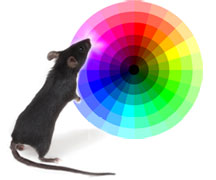Color Vision for Mice

Mice, like most mammals, are color-blind. They see a very limited number of colors - similar to what some humans with color blindness see.
Scientists (at John Hopkins and the University of California at Santa Barbara) gave mice a special gene that completely changed the animal's color vision. In basic terms, humans have trichromatic color vision. We have three types of cells in our eyes. These absorb blue, green, and red light. Since most mammals have only two types of cells, they can only see a fraction of the colors that humans see. Simply by introducing a gene, scientists discovered that the mice could distinguish colors as never before.
Researchers conducted tens of thousands of tests using colored panels. Mice received a drop of soymilk as a reward when they correctly identified which panel differed from the other two. Normal mice failed to discriminate yellow versus red lights; the genetically altered mice demonstrated their new color vision by choosing the correct panel in 80 percent of the trials.
The evolution of color vision has been a topic of intensive study for more than three decades. The new research is the most definitive yet in shedding light on the first steps that led to the emergence of color vision found today in most primates, including humans.
|
"What we are looking at in these mice is the same evolutionary event that happened in one of the distant ancestors of all primates and that led ultimately to the trichromatic color vision that we now enjoy." Jeremy Nathans |
According to scientists, this reveals significant information about the evolution of color vision. Their findings also have implications for other senses such as smell and taste. Expanding the range of other sensory input could extend the range of information that an animal senses. It could alter behavior and much more.
Furthermore, the research points to the possibility of correcting color-blindness in humans and perhaps add gene variants to enhance our color vision. (Note: Researchers have already indentified some people who appear to have four different color receptors - tetrochromats. Some animals have even more.)
Sources:
A study published in the March 23, 2007, issue of the journal Science, Howard Hughes Medical Institute
Genetic Studies Endow Mice with New Color Vision
Making mice with enhanced color vision
|
Some facts about color vision
Humans with the most common form of color-blindness and mammals with poor color vision are unable to differentiate between reds and greens. They see the world as a blend of blues, yellows, and greys. Mammals with limited color vision or none at all include mice, rats, rabbits, cats, and dogs. Nocturnal animals - such as foxes, owls, skunks, and raccoons - whose vision is specialized for dim light seldom have good color vision. By comparison, humans are color-blind in dim light. |
Also at Color Matters

 Humans, apes, most old world monkeys, ground squirrels, and many species of fish, birds, and insects have well-developed color vision. However, it's worth noting that 7 or 8 percent of human males are relatively or completely deficient in color vision.
Humans, apes, most old world monkeys, ground squirrels, and many species of fish, birds, and insects have well-developed color vision. However, it's worth noting that 7 or 8 percent of human males are relatively or completely deficient in color vision.

